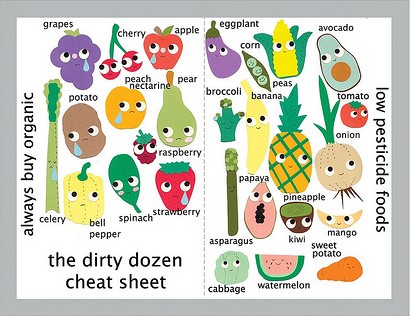As I shared my evolution of food last week (whole food, organic, junk and everything in between), it was extremely interesting to read all of your journeys as well. We are definitely meandering this “feeding our family” journey together.
Many commented that they can not afford to go organic in our meats, poultry and dairy, but try and search out the best choices for their family. We do a combination of locally grown beef and poultry, but I also dive into a lot of other ways to save money on meat too. I stated that there are certain items I try and prioritize with buying organic, and many of you inquired about that.
As far as stock piling type items, oddly enough, peanut butter and raisins are things that I lean towards in the organic world, but again, when I get free peanut butter with coupons, I jump at it. Research shows that since peanuts and grapes are heavily sprayed, there are higher levels of residual pesticides so because there is not a huge price difference with these items, so I’ll buy them in bulk.
When making decisions on produce, many look to The Dirty Dozen Organic Foods list. This list changes annually, and varies slightly based on the sources you research, but they are basically the fruits and vegetables that retain the highest amount of pesticides in the growth of the produce. Since most of us can’t afford to go completely organic, if you decide that you want to incorporate more organic produce in your diet, begin to focus on going organic with these 12, or at least soak in fruit wash and/or peel. (Again, I have not made the complete switch, but do go local, homegrown, garden fresh as much as possible.) The Clean Fifteen are those produce choices that I will save money on, and not look for sales on organic. They tend to be the ones with tougher skins.
The Dirty Dozen (worst in pesticides) The Clean Fifteen (best choices)
| Peach – 96.7% of samples tested positive for pesticides | Onion |
| Apple – 94.1% tested positive | Avocado – less than 10% tested positive |
| Bell Pepper – 81.5% tested positive | Frozen Sweet Corn |
| Celery – 94.1% tested positive | Pineapple |
| Nectarines – 97.3% tested positive | Mango |
| Strawberries | Asparagus |
| Kale | Kiwi |
| Cherries | Frozen Sweet Peas |
| Lettuce | Cabbage |
| Imported Grapes | Eggplant |
| Carrot | Papaya |
| Pear | Watermelon |
| Broccoli | |
| Tomato | |
| Sweet Potato/Grapefruit (tie) |
Again, sources on this vary, but with over twenty sites that I looked at, most attribute the research of Environmental Working Group. (While I believe in the background of this annual study, I have not endorse this agency.)
With the weather beginning to warm up, I am getting excited about garden vegetables. Although I am always excited right now, I always loose my enthusiasm right around July 1st. I need to figure out how to have a successful garden through out that hot season when bugs are attacking.
Where do you tend to buy your produce? I have a creative option I’ll share about next week. 🙂
Now I look forward to seeing all your Tasty Tuesday inspiration.
On a side note. My dear friend in real life, Carrie, is offering an amazing One Day Deal on her Grocery University – get your degree in couponing program. It’s basically a 139-minute crash course in couponing audio series, which includes a 40-page supplemental PDF and a “rock-bottom target price list.”

Simple Rules for Tasty Tuesday Parade of Foods – As always, please link directly to your recipe post and not your blog URL, so that everyone can find the recipe months from now.
Also, link back here so that everyone can join in the fun, it’s just common courtesy of blog carnivals. Please do not link up a recipe meme that you have started. While I love to support new bloggers, many are using this as a marketing arena for personal reasons, and that is not its intent. Thanks for your understanding.


From May – November, we get most of our produce from a local, organic CSA. The cost of the membership is about $13/week. I would never be able to buy the amount of produce that we receive at the grocery store for that price. We also supplement our produce in the summer from my garden. The balance of the year, I buy seasonal at the grocery store and I don’t always buy organic. Thanks for the chart, it will be helpful for making choices in the future.
Thanks for the linkup.
We must all be looking toward Spring and Summer. My post today is about CSA sign-up too. Thanks for hosting the blog hop. It’s always great to have a new dirty/clean list.
I’m hoping to sign up for a CSA when we move next month, and if not to get items from a local farmers market or farm including 1/2 a side of beef, chicken, etc. We have just recently started using Azure Standard here to order our organic products.
I am loving the visual that you found! We stick to the dirty dozen list as well. I typically buy veggies that are not on the dirty dozen list from the farm behind my house (that’s right… I can walk to it). That’s the beauty of living in the country 🙂
Great list! I have a similar one posted on my frig as a reminder, thanks!
Most of our veggies come from our own garden and are canned or frozen for winter. What we don’t grow comes from the local grocery store -washed well and blessed.
We’ve never done a CSA, but we need to look into it.
We belonged to a CSA for a few years and it was great. I must see if there is another one going now. I know the Dirty Dozen list but had never heard of the Clean Fifteen, so thanks for sharing! I’ve had a partial post sitting my draft folder for months now and now I can include this wonderful addition. I’ll be sure to link back to you too! Thanks!
thanks for hosting! my entry isn’t tooooo healthy, but we all need a balance, right? 🙂
It’s a bit scary to think what we are putting into our tummies–and our children’s tummies! Thanks for the post–and the party! Have a wonderful day. Gloria
I tend to live in denial about my “clean” or “dirty” fruits and vegetables! 😀
Thanks for the reminder for me to be more careful! 🙂
Hey Jen, Thanks for sharing the great info.
Thanks so much for hosting! Happy Tasty Tuesday!
xoXOxo
Jenn @ Peas & Crayons
I keep a Clean 15/Dirty Dozen list in my coupon organizer so I can reference it quickly at the store. I do my best to buy organic items if they are part of the dirty dozen. Right now most of our produce comes from the grocery store but come summer I’ll be visiting the farmer’s market for fresh produce. I’m also going to give container gardening another go. My dad also grows a huge garden and freezes a lot. I have corn, peas, blueberries and butter beans in my freezer all the time.
Oh thanks for the list. I always forget it! It’s good to be reminded.
Thanks for the list! I’ve finally convinced my husband about lettuce, celery and carrots {he now notices the difference in taste – apparently the health risk was not enough to convince him :)}. This will come in handy….especially as food prices rise!
Don’t know where I read it, but I’ve been doing it for a while – thin skinned stuff is more likely to be contaminated. That way if I forget my list – I’ve got a mental note!
Also – hope you’re gonna plug CSA’s as a great way to get inexpensive local produce. You know I’m an organic meat farmer and always hoping peeps are promoting clean food…
Blessings!
LIB
You absolutely know I am going to plug the CSA. 🙂 If you have a little paragraph you want to add to my post,I’d love to share it in my info.
I linked up my lemon cream pudding, and I linked back here, thanks!
I just discovered the all organic Boise Co-op and I am so thrilled. Amazingly, (because I just moved here), my new doctor told me about it. We’ve come a long way baby!
Thanks for hosting all of us today!
Thank you so much for hostessing!
I avoid a lot of those on the dirty dozen by growing my own without pesticides and avoiding eating them when they are out of season. Eating seasonally is also a part of that equation but make sure to CHECK that seasonal food and local food isn’t just covered in pesticides too. You can do that by getting to know your farmers and asking questions. I am linking up a childhood favorite recipe for savory english minced meat. All the best, Alex
Hi again…not sure if you read all your comments or not but I made the banana bar recipe in my mini muffin pan today. 😉 A-W-E-S-O-M-E!! They baked perfectly at 350 for 10 minutes!
Thanks!
YEA! So glad to hear it. 🙂
We use this list also, but I try whenever we can afford it to buy all organic since I learned that many non-organics don’t have as good of nutrition. For example, the vitamin C levels in non organic oranges are miniscule(the guesses are because the soil quality is so eroded)! That is some critical information to share I think, so that we can understand why organic is important even beyond pesticide count.
It’s hard, isn’t it?? I’m always changing how I prioritize things, but I do try to get organic and locally grown/raised as much as possible.
From Spring to late Fall, most of my produce is purchased at our local farmers market. Along with our meats, eggs, honey, soap, flowers, etc. Most of the farmers grow vegetables organically even though they are not certified organic. We also visit the local, organic u-pick farm to pick strawberries, blueberries and blackberries when they are in-season. I also have a small backyard garden and container herb garden.
During the winter, I really miss my farmers market 🙁 Most of my fresh produce during this time comes from Whole Foods, Trader Joe’s or Earth Fare. But I do have a small freezer stash of local veggies and fruits I set aside from the Spring and Summer months.
Mary Ellen
The Working Home Keeper
I buy my produce at my local grocery store and when I have time a small produce “store” that sells mainly local produce. I hope to go to farmers markets this spring/summer
I cannot seem to find out which group peanuts in the shell belong to.